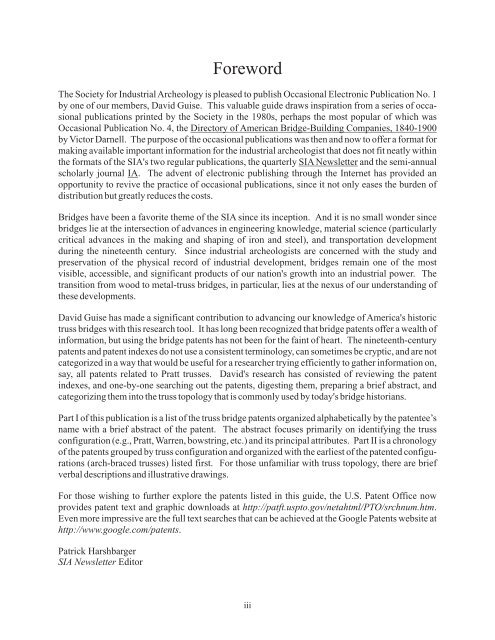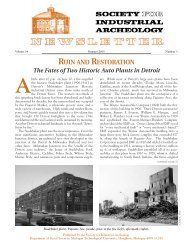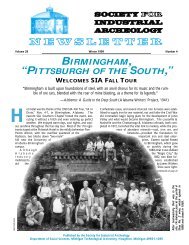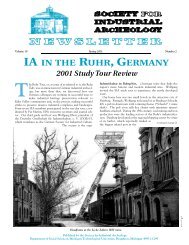Occasional Electronic Publication No. 1 - Society for Industrial ...
Occasional Electronic Publication No. 1 - Society for Industrial ...
Occasional Electronic Publication No. 1 - Society for Industrial ...
You also want an ePaper? Increase the reach of your titles
YUMPU automatically turns print PDFs into web optimized ePapers that Google loves.
Foreword<br />
The <strong>Society</strong> <strong>for</strong> <strong>Industrial</strong> Archeology is pleased to publish <strong>Occasional</strong> <strong>Electronic</strong> <strong>Publication</strong> <strong>No</strong>. 1<br />
by one of our members, David Guise. This valuable guide draws inspiration from a series of occasional<br />
publications printed by the <strong>Society</strong> in the 1980s, perhaps the most popular of which was<br />
<strong>Occasional</strong> <strong>Publication</strong> <strong>No</strong>. 4, the Directory of American Bridge-Building Companies, 1840-1900<br />
by Victor Darnell. The purpose of the occasional publications was then and now to offer a <strong>for</strong>mat <strong>for</strong><br />
making available important in<strong>for</strong>mation <strong>for</strong> the industrial archeologist that does not fit neatly within<br />
the <strong>for</strong>mats of the SIA's two regular publications, the quarterly SIA Newsletter and the semi-annual<br />
scholarly journal IA. The advent of electronic publishing through the Internet has provided an<br />
opportunity to revive the practice of occasional publications, since it not only eases the burden of<br />
distribution but greatly reduces the costs.<br />
Bridges have been a favorite theme of the SIA since its inception. And it is no small wonder since<br />
bridges lie at the intersection of advances in engineering knowledge, material science (particularly<br />
critical advances in the making and shaping of iron and steel), and transportation development<br />
during the nineteenth century. Since industrial archeologists are concerned with the study and<br />
preservation of the physical record of industrial development, bridges remain one of the most<br />
visible, accessible, and significant products of our nation's growth into an industrial power. The<br />
transition from wood to metal-truss bridges, in particular, lies at the nexus of our understanding of<br />
these developments.<br />
David Guise has made a significant contribution to advancing our knowledge of America's historic<br />
truss bridges with this research tool. It has long been recognized that bridge patents offer a wealth of<br />
in<strong>for</strong>mation, but using the bridge patents has not been <strong>for</strong> the faint of heart. The nineteenth-century<br />
patents and patent indexes do not use a consistent terminology, can sometimes be cryptic, and are not<br />
categorized in a way that would be useful <strong>for</strong> a researcher trying efficiently to gather in<strong>for</strong>mation on,<br />
say, all patents related to Pratt trusses. David's research has consisted of reviewing the patent<br />
indexes, and one-by-one searching out the patents, digesting them, preparing a brief abstract, and<br />
categorizing them into the truss topology that is commonly used by today's bridge historians.<br />
Part I of this publication is a list of the truss bridge patents organized alphabetically by the patentee’s<br />
name with a brief abstract of the patent. The abstract focuses primarily on identifying the truss<br />
configuration (e.g., Pratt, Warren, bowstring, etc.) and its principal attributes. Part II is a chronology<br />
of the patents grouped by truss configuration and organized with the earliest of the patented configurations<br />
(arch-braced trusses) listed first. For those unfamiliar with truss topology, there are brief<br />
verbal descriptions and illustrative drawings.<br />
For those wishing to further explore the patents listed in this guide, the U.S. Patent Office now<br />
provides patent text and graphic downloads at http://patft.uspto.gov/netahtml/PTO/srchnum.htm.<br />
Even more impressive are the full text searches that can be achieved at the Google Patents website at<br />
http://www.google.com/patents.<br />
Patrick Harshbarger<br />
SIA Newsletter Editor<br />
iii






